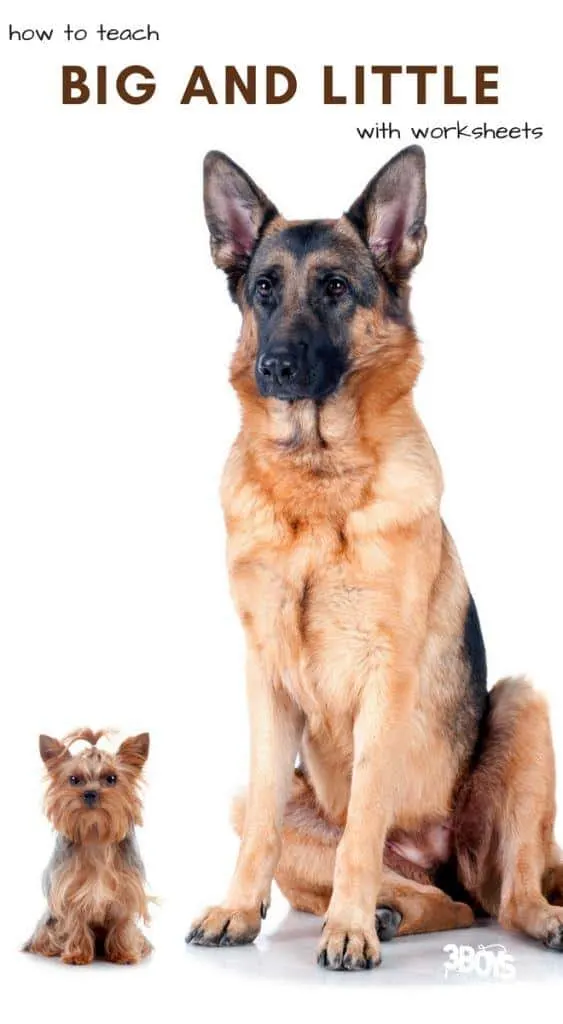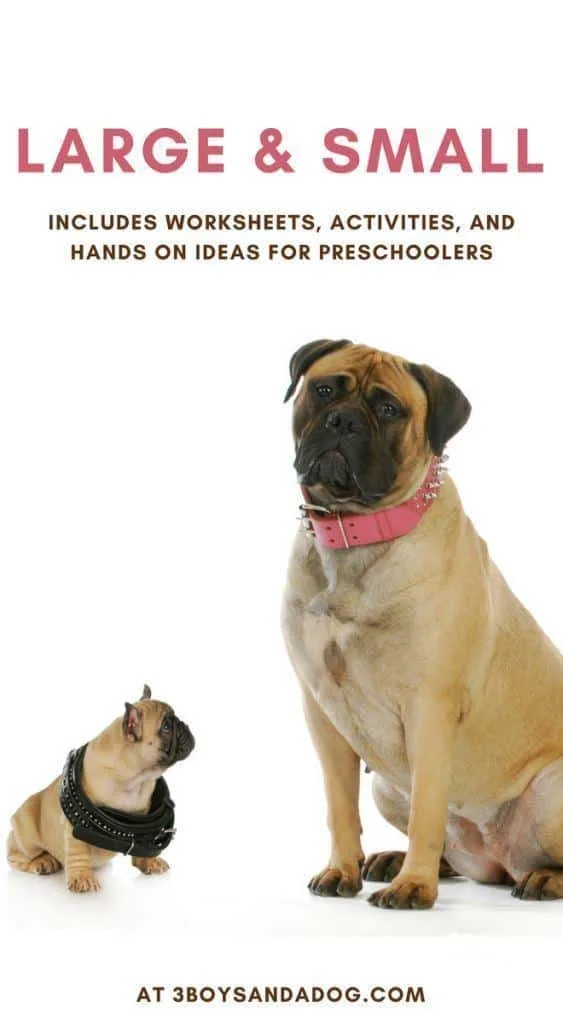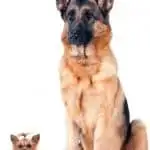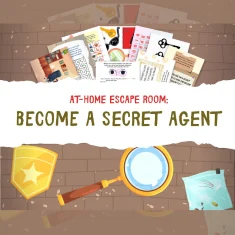The concept of big and little can be a fun one for your preschooler to learn. Sometime around the age of 2 your child can start to comprehend the concept of big and little. Learning about big and little is a way of teaching your child to observe what they see around them.
These free printable big and little worksheets will help you to re-enforce this concept to your preschool children!
The Importance of Teaching Big and Little Concepts to Children:
Providing your children with the opportunity to learn early math skills is extremely important. In fact, teaching the big and little concept to young children will help to provide the foundation children need to succeed in elementary school and beyond.
It is important to build lessons in early childhood around the basic skills that build up to advanced mathematics skills your child will use in both high school and post secondary education.
The big and little concept is an important place to start for many reasons. Not only will it help them to develop skills necessary to learn different units of measurement, but it will have a huge impact on their understanding of the world around them, increase their mathematical understanding and help to condition them to make informed decisions as an adult. From preschool to elementary school, kids are setting the foundation for future life skills.

The Early Years
Throughout the early years of your child’s life they will start to explore and notice mathematical dimensions of their surroundings, being able to identify the difference between things like a big building and a small one.
It is only natural that your children are fascinated by variability in size. Taking great delight in the vast difference between the large size of things like skyscrapers, trees and elephants and the slightness of things like caterpillars and ants. The magnetism of learning what’s smaller or bigger in comparison to each other fosters your child’s curiosity about different units of measurement. From learning about inches to miles and pounds to gallons, measurement is an incredibly important lesson for young kids to learn about math. This is because measurement is a very fundamental concept when it comes to science and technology. Without it, it would be incredibly difficult to form theories and navigate the world around us.
Not only do basic concepts help to build early math skills, but they can also help to strengthen your child’s vocabulary, teaching them the correct way to identify differences verbally and help with reading and other building blocks of early education that will give them the knowledge they need to succeed in school and their daily lives.
In School
Basic Math concepts like big and little have a huge impact when it comes to kids being able to make sense of the world around them. This helps them to build a solid foundation for success in their schooling. The large and small concept will help your children to develop their mathematical understanding, helping to carry them through elementary and middle school. Learning big and small also helps to condition your children to move on to more complicated math concepts like geometry.
Basic math concepts are not only used in math courses, but will also be applied through social studies, science and other subjects, making them incredibly important to learn early on. Considering these courses are important to your child’s educational future, it’s important to start building the foundation now. Learning the large and small concept is a great place to start, especially when they are still young.
Once your child reaches high school, they will need to be proficient in mathematics to achieve success in course work that leads to higher education and technological literacy, making it extremely important to their post secondary education, and success as an adult.

In Adulthood
When your child has finished school, they will be required to have a broad range of mathematical understanding to have the ability to make informed decisions when it comes to things like their households, lives, jobs and community. We, as adults use the big and little concept consistently in our daily lives translating to measure things like distance and more. Having an in-depth knowledge and understanding of these basic math concepts from a young age, will help to ensure that your children develop the confidence to use them in their every day lives once they reach adulthood.
Basic math concepts like big and small builds reasoning that leads to understanding and comprehension. Teaching them early on will help your children to develop a mentally organized way of thinking. It is a big task to teach your children these concepts because they are not only important to their early years, but also have a great effect on their schooling and how they function as adults. Taking some time out to find activities and methods to foster your child’s learning, like big and little worksheets, is a small price to pay for a big return in the future.
How to Teach the Large and Small Concept in Everyday Life
- Play with sorting and stacking toys – Sorting and stacking toys are a great way to teach big and small as they won’t fit properly together if they aren’t arranged properly by size.
- Use Real life experiences – Use the words “Big and Small” in everyday situations. Go out on a walk and talk about how big the trees are compared to the small birds. Using the words in context will help your children to gain understanding of the concept.
- Sort household items – Hunt around your home for items that are big and small and then help your children sort them by size.
- Use pictures– Once your child gains understanding of the concept with real objects, move onto looking at pictures to identify size difference. Just make sure it’s somewhat obvious what is big and what is small to the child.
- Use printables and worksheets – Big and small printables and worksheets are a great way to teach your children the big and small concept. Work with them to identify the differences.
Big and Little Worksheets:
Big and Little: Dinosaurs – A cute group of big and little worksheets using dinosaurs. Boys love dinosaurs, as do many girls!
Included in this group of printables are:
Big and Little: 3 Little Pigs – Let the kids learn the differences between big and little using some of their favorite story time characters.
Included in this group of printables are:
Large and Small Worksheets – Kids practice the concept of big and little through matching, drawing and identifying which item on a page is the biggest or smallest.
Included in this group of printables are:
- Big and Small Circle One
- Big and Small Matching
- Smaller Worksheet
- Smallest Worksheet
- Bigger Worksheet
- Biggest Worksheet
Other Big and Little Worksheets
- Large and Small Comparison Worksheets – A coloring sheet that asks children to identify which picture is large and which is small. Four different printables.
- Find Big and Small – Find and color the big animal in each section. Circle the small animal.
- Find the Biggest – Color the biggest item in each row.
- Find the Smallest – Color the smallest item in each row.
- Draw Bigger – Name the shape and draw a bigger one.
- Big and Small – Draw a line from the small item to the matching big item.
- Draw Smaller – Name the shape and draw a smaller one.
How do learning printables help children?
Learning printables are a hugely popular tool for helping children engage in learning activities. Not only do they make it easy to see school or assigned work, but they save time and give children a sense of victory upon completion.
Printables come in many varieties, from word searches and color-by-numbers to mazes and educational quizzes. All are highly effective for teaching young minds.
Through the use of grade-specific colors and themes, learning printables can also help teach early concepts such as identifying letters of the alphabet, numbers on clocks, or simple math which saves the parent or educator valuable time constructing the lesson plan.
Additionally, printable worksheets simplify planning for home education with organized activities that are age-appropriate and focus on specific topics.
Ultimately, learning printables provide an enjoyable and reliable way to teach children both inside and outside the classroom in a manner that is proven to be successful.
What are fun ways to teach children the difference between big and small sizes?
There are many fun ways to help children learn the difference between sizes of objects. Depending on their age and interests, parents and teachers can come up with creative activities to make learning size comparisons more enjoyable.
One way could be to draw a graph on the floor or wall showing “small, medium, and large” sections, then have kids drop different types of toys into each section.
Another idea is to make paper cutouts of various shapes and sizes, then have kids sort them into separate sections of a table, with one section designated for small shapes and one for large shapes.
Fostering an environment where creativity is encouraged shows that learning can take place in engaging ways.
There’s no shortage of entertaining ideas available to help kids understand the concept of big versus small sizes!
How often should we use learning printables in our daily learning habits?
Learning printables can be an excellent tool to help acquire knowledge and skills, but how often they should be used in our daily learning habits is largely dependent on the individual learning goals and preferences.
Some may find them helpful as daily reviews, while others may want to use them only occasionally as part of a larger study plan.
It’s important to break down your learning into manageable steps and determine how best learning printables fit into your routine.
Maybe they are great for helping organize information or keeping track of vocabulary words, or perhaps they offer great challenges that you can use strategically throughout your study process – the only limit is imagination.
Incorporating printables into your learning doesn’t have to take up a large portion of your time either; a few minutes spent each day honing an essential skill can make a big difference!






samir
Tuesday 21st of August 2018
Thank you I like your post very much because people do not understand a small child well. But what you should explain to a small child in this post and what a big child should explain in this post has been told in this post.
I lecture the post. And I am also happy to share this post with my friends too.
I am a seo. If you are interested in marketing then visit my website.
iGameMom
Tuesday 11th of March 2014
What a fun set of printables. Pinned to my free online learning resource board.
Jill
Monday 10th of March 2014
Big and Little really is a fun concept for kids to learn. Thank you for sharing this great resource! Thank you for stopping by the Thoughtful Spot Weekly Blog Hop this week. We hope to see you drop by our neck of the woods next week!
Natalie AfterschoolForSmartyPants
Thursday 6th of March 2014
Thank you for linking this post to After School Link Up!
Jill
Saturday 21st of September 2013
Teaching the difference between big and small is fun with these activities. Thank you for linking up this week to the Thoughtful Spot Weekly Blog Hop :-)